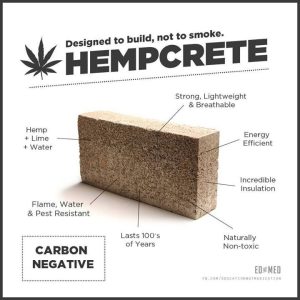 What is Hempcrete?
What is Hempcrete?
Hempcrete is a bio-composite made of the inner woody core of the hemp plant mixed with a lime-based binder. The hemp core or “Shiv” has a high silica content which allows it to bind well with lime. This property is unique to hemp among all natural fibers. The result is a lightweight cementitious insulating material weighing about a seventh or an eighth of the weight of concrete. Fully cured hempcrete blocks float in a bucket of water. It is not used as a structural element, only as insulating infill between the frame members though it does tend to reduce racking. All loads are carried by internal framing. Wood stud framing is most common making it suitable for low-rise construction. Hempcrete buildings ten stories high have been built in Europe.
The Science Behind Building with Hempcrete
Predominantly, some form of concrete has been used by builders at least as far back as the days of the Roman Empire. Today, it is made from sand and aggregate, with cement as a binder. Cement is the big energy user in the process of making concrete. It is manufactured from a range of materials, such as limestone, shells, chalk. shale, and clay. These ingredients are heated to a high temperature to form rock that is then grounded into powder. Hempcrete, on the other hand, is made from hemp mixed with a lime binder and water; it does not require heat to produce. This material can be formed to fit between the studs of a house as building blocks or bricks. Because it is less dense than regular concrete, it weighs significantly less and therefore requires less strain during the building process. Hemp can also be used like stucco to protect the outside walls of new and existing homes from moisture.3As a vapor-permeable material, it can absorb water when it’s raining and then expel it when the sun is shining. This is a huge advantage because, for many building materials, moisture problems can lead to mold and rot. Research shows that hempcrete can hold more than 1,300 pounds of water vapor in a cubic meter of the material.4 This material does well in relative humidity above 90%, and it can hold the water vapor without degrading. The lime binder used in making hempcrete also has antimicrobial and antifungal properties that keep the coated surfaces of walls resistant to mold. While wood or steel framing has better load-bearing qualities, one study found that, as infill between traditional framing, hempcrete strengthens the walls against buckling.5
In addition, hempcrete is a much better insulator than traditional concrete, though how much better depends on the moisture content and the density of the material. The R-value of a material is a measure of its resistance to heat flow through a wall.6The higher the R-value, the better the wall resists losing heat in the winter and gaining heat in the summer. The R-value of hempcrete is similar to that of other fibrous insulations, such as straw or cotton, which have an R-value between 2 and 4 per inch. One paper estimates that hempcrete provides an R-value of 2.4 to 4.8 per inch. To compare, concrete has an R- value of 0.1 to 0.2 per inch, making it an insufficient insulator. Whole wall R-values depend on the framing material, the presence of thermal bridges, the kind of insulation, and the quality of its installation. For example, fiberglass insulation can be compressed and that lowers its effective R-value. Also, insulation could be installed with gaps in the wall cavity, and that diminishes its value as an insulator, as well. Hempcrete won’t compress like fiberglass and can be cut more easily to fill up the space between studs.
Benefits of Building with Hempcrete
Hempcrete is an energy-efficient, low-impact, water-smart building material that offers a smaller carbon footprint than other home building materials. An alternative to concrete, which is very energy intensive, hempcrete can be an integral part of home building, using just enough energy to keep its occupants warm in the winter and cool in the summer. Like any house material, hempcrete has its share of advantages and drawbacks. While it is a good insulator, it is not the best load-bearing material. It can handle moisture well, reducing the possibility of mold growth and the attendant poor indoor air quality in homes; however, it also uses a lot of water to grow. What is chiefly important to many environmentalists, though, is that the hemp plant used to make hempcrete absorbs carbon and is relatively easy to grow and harvest.
Sources:
Gunshinan, J. (2021, February 19). The benefits of building a Hempcrete House. Treehugger. Retrieved July 8, 2022, from https://www.treehugger.com/hempcrete-house-5113218
What is Hempcrete? American Lime Technology Website RSS. (n.d.). Retrieved July 8, 2022, from http://www.americanlimetechnology.com/what-is-hempcrete/



